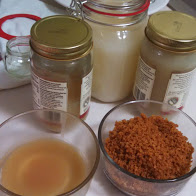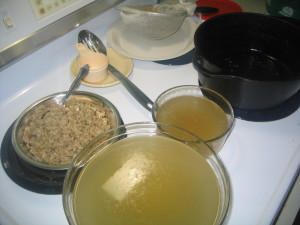One thing I like about making lye soap is, it only requires you to use ingredients from your own kitchen cabinets to the exception of the sodium hydroxide . Lye soap is made out of oils, distilled water or rain water, and sodium hydroxide.Three types of oils and fats are used in different proportions to make lye soap:
Liquid oils include olive oil, grape seed oil, avocado oil, almond oil…They increase the conditioning of the soap.
Solid vegetable oils: coconut oil and palm kernel oil. They increase the lather.
Palm oil and animal fat: palm oil, beef tallow, lard, bison fat, duck fat….They make the lye soap hard and creamy.
The third type of oils especially lard is the center of our attention today.
Lard is a rendered pig fat. It is used in lye soap, cooking, baking, and frying. It has a high smoke point 390 degree F(192 degree C) as opposed to Butter 250-300 degree F(121-149 degree C) or Extra Virgin Olive Oil 375 degree F (195 degree C).
Be aware, most lard sold on the market contains hydrogenated oils. when I decided to make lye soap without palm oil as it colors my soap orange, I bought lard from a grocery store. At home I read the ingredients: lard, hydrogenated lard, BHA, propyl gallate, & citric acid. Therefore, I didn’t use it.
Cooking with lard is not as unhealthy as some people might think. It might even be better than butter and most oils on the market if you use the right type of lard. The best way to be sure is to make your own.
First find a local butcher to get your pig fat. I would not advice pig fat from a grocery store as those fat will be from pig raised in confined environment, feed on grains and full of antibiotics. From your local butcher, you can find out how the pork was raised. For instance, I got the pig fat that came from pork raised on pasture.
Ask the butcher to cut the fat into pieces or grind it for you.
Homemade Rendered Lard
All you will need:
cast iron pan, spoon, colander, gauze fabric, bowls, sanitized glass bottles, and of course the pastured pig fat
Put the fat in the pan at low heat or at 9 o’clock. Slowly, it will melt.
When you have enough oil in the pan, strain it using the colander lined with the gauze fabric. Strain often. You don’t want to burn your oil or expose it to heat for extended period of time.
Return the meat and fat back to the pan to melt again. Set the strained oil aside to cool.
Pour in the clean glass bottle. repeat the process until no oil is coming out the residue in the pan. let the residue crisp up and snack on it. Keep the lard in the fridge for few weeks or in the freezer for longer period of time.
Use it to make your own soap, or use it in cooking. At least you know where your cooking fat in coming from and it is free from additives. It could be any better quality than that.
Did you know Lard could be healthier than Butter?
Lard is low in saturated fat and high in monounsaturated fat compared to butter. Additionally, it is low in omega-6 and high in omega-3 if it comes from free range pork raised on greens not grains. Dr. Weil, Andrew:”Q&A Library“.Weil,Andrew M.D.Weil Lifestyle,LLC. 10 July 2012.Web. 8 Jan 2015.
If you are curious to know how Dr. Weil eats, check his Anti-Inflammatory Food Pyramid.
Do you make your own cooking oil? Please do share it with us.
As a reminder the content is not a medical advice.





